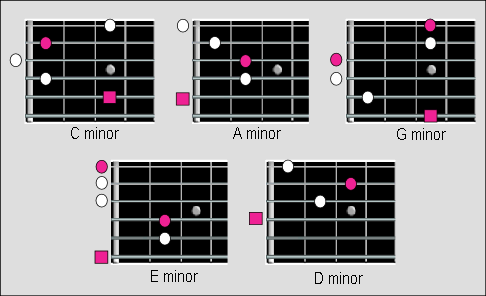Most teaching on the CAGED system focuses on major chords and scales. It’s pointless going to all that trouble learning a system and then only using a small percentage of it’s versatility. The whole point of making the most of a method like this is to get you learning the fretboard and visualising the notes in an efficient, usable manner, one that avoids the all too common method of thinking only in shapes and scale patterns. CAGED is just a term. As we progress through these lessons we want to start thinking less and less about C-A-G-E-D patterns and just start thinking about chords and chord tones.
Minor chords based on the open positions are less popular than their major counterparts because they are hard to use and require a more finger stretches, the worst being the G minor and C minor chord forms. Sure, it’s great if you can do them but it’s not that important for lead guitar. What’s more important is knowing where the notes are and being able to visualise the chord patterns. A lot of guitarists when learning stuff like this ten to think of a chord as needing to be played on all five or six strings. The thing to realise is all non seventh major and minor chords are Triads that just contain three notes. Getting used to these triad shapes is possibly more useful than thinking about chords that use all six strings.
The diagrams below show the minor chords in the CAGED system. Learn them and play around with them over jam tracks. The ones that are difficult, just break them up into smaller string groups.

In the next lesson we will learn how seventh chords are applied to the CAGED system and then we can move onto breaking these chord patterns down into smaller parts. Remember, creating creative and interesting solos relies on a command of the fretboard, the more options you have the better you are going to be. Once we have learnt all these patterns, all we need to do is understand how they are formed and then we can begin putting them to real world use by combining them with scales and starting to think about the notes in a solo instead of relying on scale patterns which lead to predictable guitar playing.
Unless I missed it, you need to explain more than just the “dots” and the roots. It’s important for a student to understand what drives a chord to be major or minor. 1-3-5 is a major chord. 1-b3-5 is a minor chord. 1-b3-b5 is a diminished chord. So the difference in the major chord CAGED system is the process of dropping the major third to a flat third. This creates the minor chord. Additionally dropping the 5th would create a diminished chord.
Showing the dots and the root is fine. Getting a student to think about what the other “dots” are and their relationship to the chord is the key to understanding the musical structure.
Memorizing “dot” locations won’t help you learn the fret board. Notes are the answer to the equation of the interval. Understanding the intervals helps you map the fret board, and understanding the relationship of the notes of any scale in reference to the intervals makes you a musician. Targeting the root, third, or fifth at the moment of the chord change helps you build solo accuracy and gives your improvisation a solid and musically correct sound.
In order to better harmonize the CAGED system with the theory of harmony, the system has been extended slightly.
Some chord forms have been assigned two names.
The C-shape in major was assigned the Bm7-form.
C = 032010 Bm7 = x20202 or 22020x
both forms of chords have their roots on the A and B strings.
Adding the seventh to a minor chord makes it easier to grasp. For minor chords, the seventh has no effect on the chord function (tonic dominant subdominant).
Also, the Gm7 shape (3x333x) is easier to grip.
The E-form in major was alternatively called F-form.
Alternatively, the A-form was also called Bb-form. see. the typical chords of a F major scale: Bb F C7 Gm7 Dm Am.
On the other hand, it is not so easy to derive a chord form from the typical chords of the E major scale. (A E B F # m C # m G # m).
If one were left alone in the caged system, the chord designations would run counter to the theory of harmony. F-shape C-shape A-shape ???
In practice, I always use the name that is the simplest for the context
However, with the slight extension of the caged system, this system can be extended to all areas of visual representation of handle images and scales, and used for typing or cataloging.
compare: https://de.wikibooks.org/wiki/Gitarre:_Formen-Systematik
ps .: forgive me small translation errors.
greeting from Germany
Mjchael